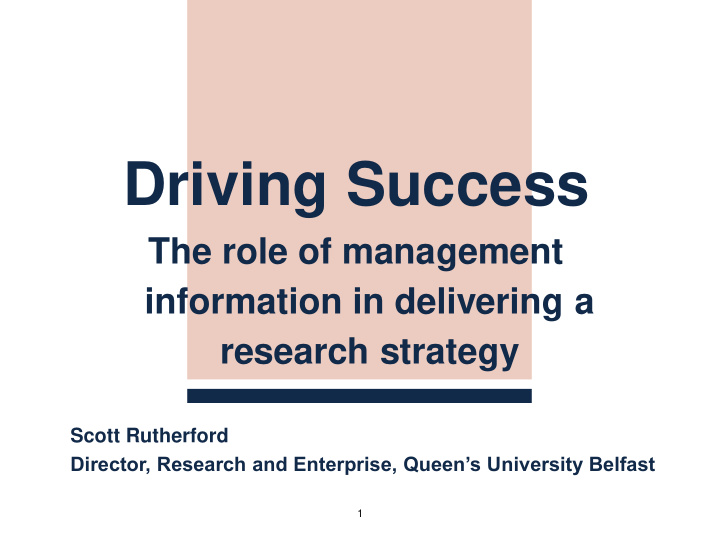



Driving Success The role of management information in delivering a research strategy Scott Rutherford Director, Research and Enterprise, Queen’s University Belfast 1
Strategic context Reducing government grant funding for teaching and research Increasing concentration of government research funding Rise of interdisciplinary and international grand challenge themes Drive for increased multi-partner/ industry-academic consortia Competition to attract the best research leaders globally Relentless need to demonstrate social and economic impact 2
Reduced Government funding 3
Concentrated funding £60,000,000 UK Medical Research Council £50,000,000 £163.8m of £301.4m allocated to top 5 institutions £40,000,000 ( 54.3% ) £30,000,000 £20,000,000 £10,000,000 £0 4
Responding to the challenge • Single research groups, single institutions, or even single nations, do not have sufficient critical mass, expertise or resources to address these major societal questions, so collaboration is essential and expected; ‘size matters’ • Research projects are more multi-disciplinary, -partner, -institution and – national = added complexity and risk; competition for resources remains fierce • Big challenge for universities to work coherently and make the whole > sum of the parts • Must demonstrate how we add to the totality of activities rather than appear as disparate groups of individual research projects – very difficult to achieve • Need to work in partnership with other universities, (regionally, nationally and internationally) much, much more 5
A strategic framework Strategic Priorities Cross-cutting themes 6
A structural framework 7
A challenge-led framework 8
A challenge-led framework 9
A performance framework 10
How can Research Information Help? • Create a clear evidence base to work from • Help understand strengths and shape strategy • Assist in finding opportunities, collaborators, talent etc • Begin to benchmark performance meaningfully • Really monitor progress against strategic objectives But (generally)… • Current systems used by universities are not fit for purpose • They lack effective project management structures • Universities are poor at delivering major projects • There is a lack of quality products available to the sector 11
Making it happen… Initiatives at Queen’s University Belfast: Strand 1: to aggregate holistic research data from disparate sources (PURE SYSTEM) Strand 2: to drive action across research leaders in managing the research portfolio (GRANTS SCORECARD) Strand 3: to understand citation performance and collaborative performance (PUBLICATION IMPACT PLANS) 12
Strand 1 To aggregate holistic research data from disparate sources (PURE SYSTEM) 13
Aggregating key research data 3,000 3,000 4,200 3,000 60,000 1,250 Researchers PG Students Applications Awards Outputs Activities 14
Pure Profile – Engaging Academic Staff 15
Research Portal: External Profiles 16
Internal Profile: Head of Department Physics Your Their Their Their Academic Associated PG Research Awarded Staff Publications Student Grant Supervision Funding 17
Balanced Metrics Reporting Suite 18
Strand 2 To drive action across research leaders in managing the research portfolio (GRANTS SCORECARD) 19
Managing at corporate level 20
Managing at Faculty level 21
Managing at School/ Dept. level 22
Delving deeper 23
Strand 3 To understand citation performance and collaborative performance (PUBLICATION IMPACT PLANS) 24
Driving publication impact • Pilot collaboration for three years with supplier • Raising awareness of citations • Exploring links between citations and league tables • Focused ‘deep dive’ sessions with three Departments. • Heavy emphasis on benchmarking against peers 25
Initial findings • Queen’s had a lower publication output and citation impact compared to peer universities (ave cites per paper) • International collaboration generally increases citation impact – Queen’s performed well, relative to peers, but still a strong concentration with locally based institutions. • Academic-Corporate Collaboration generally increases citation impact – but Queen’s had a lower level of collaboration than peers • Review and multidisciplinary journals tended to rank higher in citations than original research journals • Queen’s had a lower proportion of publications in the top quartile of journals than peer universities 26
International Co-authorship 27
Journal quality 28
Academic led – A Departmental pilot 29
Driving action… • Developed targeted ‘Publication Impact Plans ’ • Aiming for upper centile journals • Mentoring plans for early career researchers • Appraisal-linked targets and evaluation • International ‘placement’ schemes to foster broader collaborations 30
Changes in co-authorship 31
Clear quality improvements 32
International co-authorship critical 33
Significant benchmarked progress 34
Key messages • Publication and citation metrics take time to improve • Involve credible experts – suppliers, RMA professionals • Critical to involve academics from the outset • Do not avoid disciplinary differences (e.g. Arts & Humanities) • Pick pilot areas to build understanding/ illustrate relevance • Focus on action-planning at local level – and monitor regularly 35
Recommend
More recommend